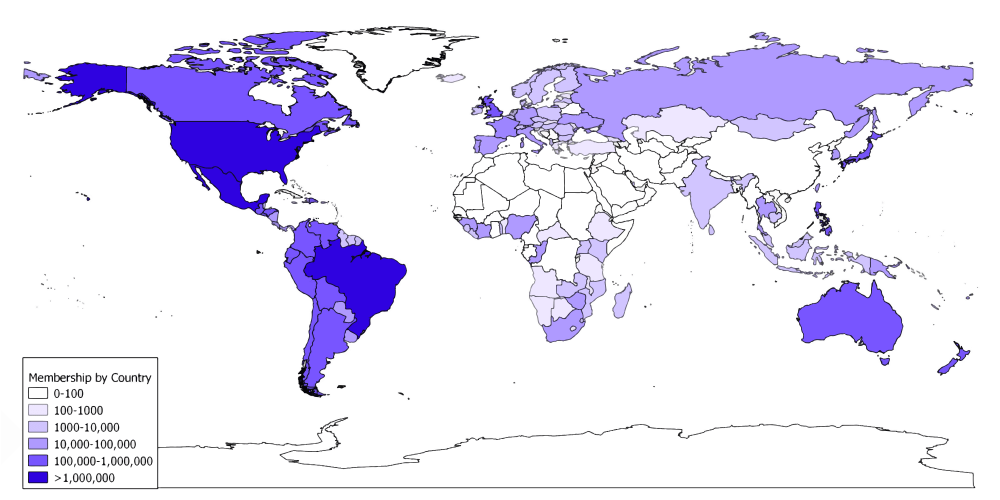This page is dedicated to the small and often overlooked group of African American Mormons who have been members of The Church of Jesus Christ of Latter-day Saints (LDS) almost since its founding on April 6, 1830. Their numbers have grown dramatically since 1978. Far larger numbers of Africans and people of African ancestry in Latin America have joined the Church after LDS leaders removed the ban on males of African ancestry holding the priesthood. In 2015 an estimated 700,000 people of African ancestry around the world claimed The LDS Church as their spiritual home including 333,000 in sub-Saharan Africa. Our goal in this project is to illuminate the personal history of selected individual African American Mormons and to explore the now nearly two century history of the Church and people of African ancestry. We do this by situating on this page all information on BlackPast.org related to the subject. It is hoped that the sharing of this information will lead to a greater understanding of the long and complex relationship between the LDS Church, black Mormons, African America, and people of African descent around the world.
Individual Entries
- Q. Walker Lewis (1798-1856)
- Joseph T. Ball, Jr. (1804-1861)
- Warner William McCary (c.1810-n.d.)
- Elijah Abel (1810-1884)
- Peter “Black Pete” Kerr (1810?-1840?)
- Jane Elizabeth Manning James (1813-1908)
- Bridget “Biddy” Mason (1818-1891)
- Green Flake (1828-1903)
- Samuel D. and Amanda Chambers (1831-1929) and (1840-1925)
- Gobo Fango (1866-1886)
- Martha Ann Jane Stevens Perkins Hall (1875-1954)
- Abner Leonard Howell (1877-1966)
- Mary Lucile Bankhead (1902-1994)
- Ruffin Bridgeforth (1923-1997)
- Helvico Martins (1930-2005)
- Raphael Abraham Frank Mensah (1934-1990s)
- Joseph William “Billy” Johnson (1934-2012)
- Eldridge Cleaver (1935-1998)
- Emmanuel Abu Kissi (1938- )
- Gladys Knight (1944- )
- Darius Gray (1945- )
- David W. Eka (1945- )
- Eugene Orr (1946)
- Elder Joseph Sitati (1952- )
- Joseph Freeman (1953)
- Thurl Lee Bailey (1961- )
- The Wyoming Black Fourteen (1969)
- The Genesis Group (1971- )
- Mia Love (1975- )
Documents, Speeches, and Public Statements:
- An Act in Relation to Service (Utah Slave Code), 1852
- The Need for Greater Kindness, 2006
- Race and the Priesthood, Statement of The Church of Jesus Christ of Latter-day Saints, 2014
Websites and Research Guides:
Genealogy:
Timeline:
1830: The Church of Jesus Christ of Latter Day Saints is organized in Fayette, New York.
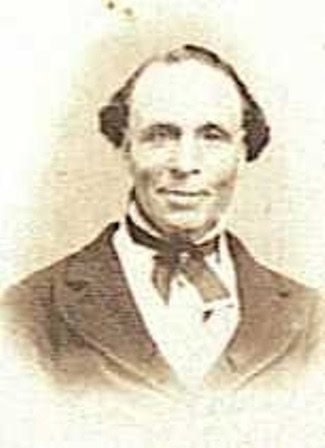
1832: Elijah Abel is baptized and joins the LDS Church. Abel becomes the first black man to be given the priesthood.
1833: LDS leader W.W. Phelps publishes a controversial editorial in the Independence, Missouri Evening and Morning Star encouraging Free People of Color to migrate to Missouri. Many residents in Missouri react negatively to the editorial and one anti-Mormon manifesto calls for the “removal” of Mormons from the state.
1836: Elijah Abel is ordained an Elder in the LDS Church reportedly by Joseph Smith. Later that year he is ordained as a member of the Seventy, the leadership body of the LDS Church and becomes a “duly licensed minister of the Gospel” to do missionary work in Ohio.
1842: Joseph Smith writes in his personal journal that enslaved people owned by Mormons should be brought “into a free country and set….free. Educate them and give them equal rights.”
1843: Joseph Smith makes a public statement asserting that blacks have souls and are a product of their environment. Given an equal environment they would be on the same level as whites.
1844: Joseph T. Ball serves as Boston Branch President of the LDS Church. Ball, who held the priesthood, served as president of the branch from 1844 to 1845. He is the first African American to serve in a leadership capacity in the Church.
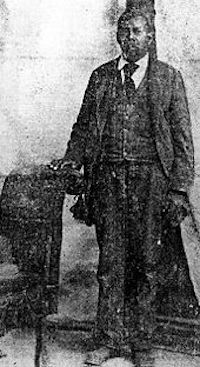
Green Flake, the slave of James Madison Flake, is baptized at the age of 15 and joins the LDS Church.
Samuel Chambers, a slave, is baptized at the age of 13.
Walker Lewis, a free black man, is ordained an Elder in the LDS Church
Joseph Smith runs for President of the United States and campaigns on an anti-slavery platform. He declares that despite slavery, all men are created equal and proposes the sale of public lands to pay for the emancipation of every slave in the nation He also calls for complete emancipation by 1850.
1846: William McCary, a free black man, is baptized and ordained in the LDS Church. He becomes a controversial figure because of his challenge of Church doctrine and is eventually excommunicated by Church leaders.
1847: Three African Americans, Green Flake, Oscar Crosby, and Hark Lay, accompany Brigham Young who leads the first Mormon pioneers to the Salt Lake Valley. The slaves of Southern Mormons, these men are sent ahead to help prepare for Mormon settlers to follow. Today, their names are inscribed on the Brigham Young monument in downtown Salt Lake City.
1851: Church leader Orson Hyde makes a statement about slavery that appears in the official LDS newspaper The Millennial Star: “The laws of the land recognize slavery, we do not wish to oppose the laws of the country….Our counsel to all our ministers in the North and South is; to avoid contention upon the subject, and to oppose no institution which the laws of the country authorize; but to labor to bring men into the Church and Kingdom of God and teach them to do right, and honor their God in His creatures.”
Elijah and his wife, Mary Ann Abel, arrive in Utah Territoriy. Abel a carpenter by trade who has helped construct LDS Temples in Kirkland, Ohio and Nauvoo, Illinois, works on the Salt Lake Temple. The couple also manage the Farnham Hotel in Salt Lake City.
1852: LDS President Brigham Young in two speeches before the Utah Territorial Legislature on January 23 and February 5, publicly announced that men of black African descent could no longer be ordained to the priesthood, though blacks could continue to join the Church through baptism and receive the gift of the Holy Ghost.
Slavery is made legal in Utah by an act of the Territorial Legislature. A slave code is also adopted. The code includes provisions not usually found in similar codes in the U.S. South. The Utah code bans intercourse between owner and slave, punishes owners who neglect to feed, clothe, or shelter their slaves or who abuses the slave. The code prohibits owners from taking their slaves from Utah Territory without the permission of the slave and requires some schooling of the enslaved child between the age of six and twenty. Any owner who violates these provisions is compelled to free his slave.
1853: Brigham Young denies the request of Elijah Abel to receive endowments. This is the first time a person of color is denied access to rituals and practices central to the LDS faith.
1854: Brigham Young arranges for the emancipation of Green Flake who eventually settles in Idaho Falls, Idaho Territory.
1856: Bridget “Biddy” Mason, and her extended family of 12, all slaves of Mormon Robert Smith, are freed by Los Angeles, California Judge Benjamin I. Hayes after they are illegally brought to California. Mason eventually becomes a wealthy property holder and philanthropist and the founder of First African Methodist Episcopal (AME) Church in Los Angeles. Smith was later excommunicated from the Church.
1860: The U.S. Census of 1860 shows Utah Territory has 59 black inhabitants including 29 enslaved people.
1862: On June 19 the U.S. Congress passed the Territorial Abolition Act which abolished slavery in all U.S. territories including Utah Territory.
1863: President Abraham Lincoln’s Emancipation Proclamation goes into force. The proclamation frees all enslaved people who remain in the areas of the United States still in rebellion against the Federal Government on January 1, 1863.
1865: The Thirteenth Amendment is passed by Congress and ratified by the required number of states. The amendment outlaws slavery throughout the United States and all territories under its jurisdiction.
1867: The Deseret Constitution (the Consititution of Utah Territory) extends suffrage to [male] persons of color following a referendum held in February and passed by an almost unanimous vote of the Territory’s white male voters.
1868: The Fourteenth Amendment which grants citizenship rights to all persons born within the United States or subject to its jurisdiction becomes law.
1870: The Fifteenth Amendment granting voting rights to male African Americans throughout the United States becomes law.
1880: Elijah Abel is again denied Temple Endowment, this time by the Quorum of the Twelve Apostles.
1883: Elijah Abel still holds the priesthood despite the earlier ban on persons of African ancestry. He is also still on record as a Seventy in the LDS Church.
In his seventies, Abel is sent to do mission work in eastern United States. He returns home to Salt Lake City in early December and dies on December 25, 1884.
1896: Utah Territory is admitted to the Union on Jan. 4, making it the 45th state.
1900: LDS President Lorenzo Snow states that he is not sure whether the existing explanations for the priesthood ban have been personal opinions or actual revelations.
Elijah Abel’s son, Enoch Abel, is ordained an Elder in the LDS Church.
1902: Jane Elizabeth Manning James receives a Special Temple Sealing. James, who lived with LDS founder Joseph Smith, indicated that she was promised by him and his wife, Emma, that she would be adopted into the Smith family. The Sealing officially represents the formalizing of that adoption.
1903: Green Flake, a pioneer LDS settler who accompanied Brigham Young on his initial migration to the Salt Lake Valley in 1847, dies in Idaho Falls, Idaho. He is 75 at the time of his death.
1934: Elijah Abel’s grandson, also called Elijah Abel, is ordained a priest in the Aaronic priesthood. The following year he is ordained an Elder in the LDS Church.
1940: A Committee is formed among the leaders of the LDS Church to “make some ruling or re-affirm whatever ruling that has been made on this questions in the past as to whether or not one drop of negro blood deprives a man of the right to receive the priesthood.”
1947: LDS leaders explore the expansion of the Church into Brazil and other areas of Latin America. There are concerns however about the large percentage of the Brazilian population that has some African ancestry.
1948: LDS Church leadership reaffirms the ban on the priesthood for those of African ancestry and indicates that “…It is not a matter of the declaration of a policy but of direct commandment from the Lord, on which is founded the doctrine of the Church from the days of its organization, to the effect that Negroes may become members of the Church but that they are not entitled to the priesthood at the present time.”
1955: Melanesian “Blacks” are given the Priesthood. LDS Church leader David O. McKay says that Melanesian blacks are defined as from a different lineage and are not under the priesthood ban. The first men from the Fiji Islands receive the priesthood in 1958 along with the Negritos of the Philippines.
1958: As the U.S. Civil Rights Movement begins to gain momentum, LDS Church Leader Joseph Fielding Smith clarifies the Church’s position on equality for blacks with the following statement: “No church or other organization is more insistent that the Church of Jesus Christ of Latter-day Saints that Negroes should receive all the right and privileges that can possibly be given to any other [race] in the true sense of equality as declared in the Declaration of Independence…They should be equal in the matter of education. They should not be barred from obtaining knowledge and becoming proficient in any field of science, art, or mechanical occupation. They should be free to choose any kind of emplyment, to go into business in any field they may choose and the make their lives as happy as it is possible without interference from white men, labor unions, or from any other sources. In their defense of these privileges the members of the Church will stand… If a Negro is baptized and remains true and loyal, he will enter the celestial kingdom…but we cannot promise him that he will receive the priesthood.”
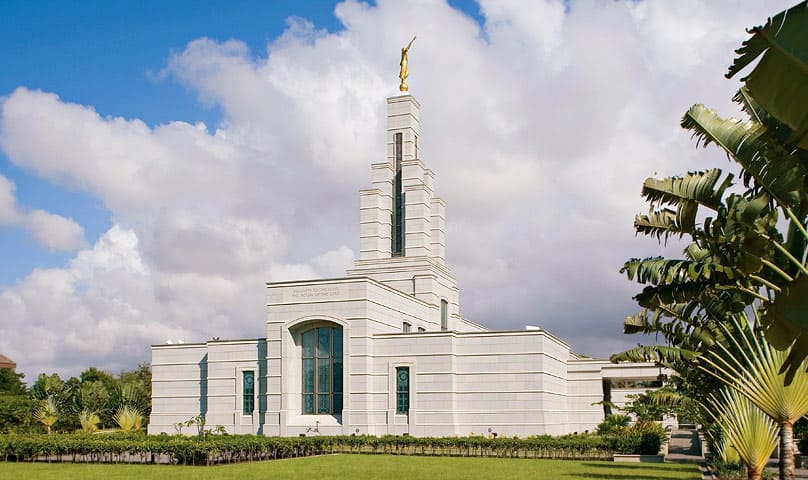
Accra, Ghana
me
1962: LDS President David O. McKay calls four missionaries to serve in Nigeria. The President permits baptism of Nigerians into the faith but maintains the ban on persons of African ancestry in the priesthood.
Sometime in 1962 Dr. A.F. Mensah, a black religious leader in Ghana, joins the LDS Church. He converts several others and sets up the first LDS Church congregation in sub-Saharan Africa. This is done despite the fact that males of African ancestry cannot hold the priesthood in the Church.
1963: On June 7, an article in The New York Times quotes LDS Apostle Hugh B. Brown as saying, “We are in the midst of a survey looking toward the possibility of admiting Negroes [to the Priesthood].
Later that year Brown makes a statement on Civil Rights at the General Conference of the LDS Church. He says: “We have consistently and persistently upheld the Constitution of the United States and as far as we are concerned this means upholding the constitutional rights of every citizen of the United States… We call upon all men everywhere, both within and outside the Church, to commit themselves to the establishment of full civil equality for all of God’s children. Anything less that this defeats our high ideal of the brotherhood of man.”
1964: Dr. A. F. Mensah gives a copy of the Book of Mormon
to fellow Ghanaian J.W.B. Johnson who joins the Church and begins to spread the gospel among fellow Ghanaians.
1965: The Nigerian government denies visas to Mormon missionaries, effectively forbiding Mormon Missions in the country because of the priesthood ban but it allows its citizens to become members of the LDS Church.
1969: In October fourteen black University of Wyoming football players decide to protest LDS policies regarding race by announcing that they will wear black armbands during the upcoming game with Brigham Young University (BYU). Wyoming head football coach Lloyd Eaton learns of the protest and immediately suspends all fourteen players from the team. The proposed protest and the subsequent suspension focus for the first time national attention on the LDS policy regarding the priesthood and other examples of discriminatory practice directed against black LDS members.
One month later Stanford University announces that it will no longer compete with BYU varsity sports teams as a protest against “…alleged racial discrimination by the Mormon Church.”
1970: A January basketball game between BYU and the University of Arizona is disrupted when nine black students walk onto the court just before halftime to protest LDS Church racial policies. One week later 3,000 students at the University attend a rally demanding the institution sever relations with BYU.
In February and March anti-BYU protests spread to the University of Washington, the University of Wyoming, Colorado State University, California Polytechnic State University (San Luis Obisopo) and the University of New Mexico. By the early Spring student organizations at six universities—The University of Arizona, Arizona State University, The University of New Mexico, Colorado State University, the University of Wyoming and the University of Hawaii—all call for their institutions to sever ties with BYU athletics. The Faculty Senate at the University of Washington also calls on its institution to end its athletic ties with Brigham Young University.
In the wake of these protests, LDS President David O. McKay tells the Salt Lake Tribune that “There is no doctrine in this church and there never was a doctrine in this church to the effect that the Negroes are under any kind of divine curse.”
1971: The Genesis Group is founded in Salt Lake City, Utah.
The organization formed under the direction of LDS President Joseph Fielding Smith and led by Ruffin Bridgeforth, Jr., is to provide fellowship for black LDS members in the Salt Lake City area and to reactivate black members who are no longer involved in the Church.
1972: Bennie Smith enrolls in Brigham Young University and becomes the institution’s first black football player. Smith complains of racial prejudice on the BYU campus and is suspended from the team before completing his first semester.
1973: Spencer W. Kimball becomes the new LDS Church President and immediately addresses the priesthood ban. He says: “I am not sure that there will be a change, although there could be. We are under the dicates of our Heavenly Father, and this is not my policy or the Church’s policy. It is the policy of the Lord who has established it, and I know of no change, although we are subject to revelations of the Lord in case he should ever wish to make a change.”
1974: Gary Batiste enrolls in Brigham Young University and becomes the first black basketball player at that institution.
LDS Church leaders remove the ban on African American males serving as Boy Scout Troop leaders in Church-sponsored troops.
1976: Douglas Wallace, a white LDS member in Portland, Oregon, holds a press conference and baptizes Larry Lester, a black man in a motel swimming pool. Wallace then ordains Lester a member of the Aaronic Priesthood. Within weeks Church leaders excommunicate Wallace and ignore the baptism of Lester.
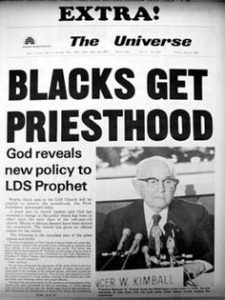 1978: On June 8, the First Presidency of the Church of Jesus Christ of Latter-day Saints announces that all worthy male members of the Church may be ordained to the priesthood without regard to race or color.
1978: On June 8, the First Presidency of the Church of Jesus Christ of Latter-day Saints announces that all worthy male members of the Church may be ordained to the priesthood without regard to race or color.
Two weeks later Joseph Freeman is the first black male to be officially ordained an Elder and granted the priesthood in the 20th Century.
1979: One year after the Church lifts its ban on males of African ancestry holding the priesthood, there are approximately 1,700 LDS members in Nigeria.
Stanford University ends a decade-long ban on athletic competition with Brigham Young University.
1980: The LDS Church formally establishes its first West African Mission.
1983: Former Black Panther Party leader Eldridge Cleaver is baptized and joins the LDS Church in Oakland, California.
1988: The first black African stake is organized in 1988 in Aba, Nigeria, with David W. Eka as its president.
1990: Helvecio Martins, a Brazilian who joined the LDS Church sometime before 1978, becomes the first black General Authority in the Church. He is also a member of the Quorum of the Seventy, only the second person of African ancestry after Elijah Abel to be elevated to that body.
1995: National Basketball Association player Thurl Bailey becomes the first black professional athelete to join the LDS Church.
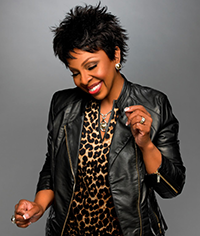
1997: Popular entertainer Gladys Knight is baptized and joins the LDS Church.
2002: Robert Foster becomes the first black student body president of Brigham Young University.
2005: Jackson T. Mkhabela is called as stake president in Soweto, South Africa. All other stake presidents in South Africa had been white although stakes had black counselors. While there have been other black stake presidents in Africa and Latin America, Elder Mkhabela is the first black stake president in South Africa.
2009: Elder Joseph W. Sitati of Nairobi, Kenya is Called as a General Authority of the Church. He is the third person of African ancestry, and the first on the African continent, who is elevated to the Quorum of the Seventy after Elder Helvecio Martins of Brazil (1990-1995) and Elijah Abel (1839-1884).
2013: The Church releases a lengthy doctrinal and historical statement called “Race and the Priesthood” which disavows theories in the past that black skin is a sign of divine disfavor or curse.
2014: Mia Love becomes the first black member of the LDS Church to be elected to the United States Congress. She is also the first black member of Congress elected from Utah.
For a more detailed timeline of African Americans and the LDS Church see the timeline at BlackLDS.org.
